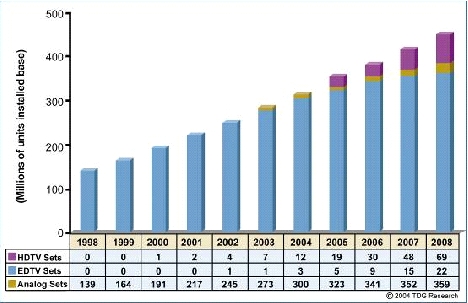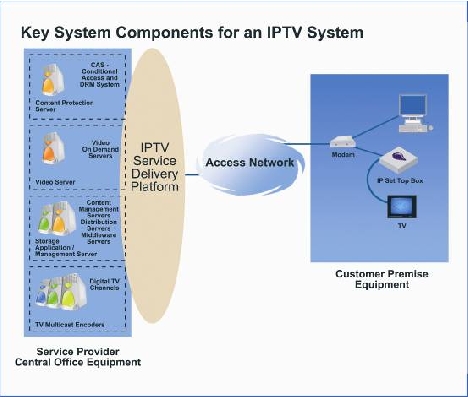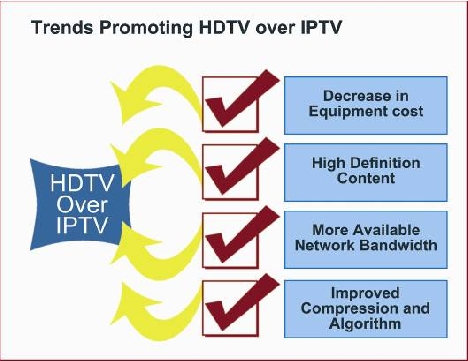|
 |
|
Television service providers need to consider several key options when offering HDTV in their IPTV systems. If providing many choices of HDTV programming is an objective of the service provider, IPTV is one of the most reasonable ways to provide access to HDTV programming. A traditional television broadcast system has a limited amount of capacity and if many of the programming channels were converted to HDTV, the broadcaster would need to reduce the number of available channels. Once an IPTV system is setup to offer HDTV, adding additional HDTV programs is not an issue.
What is HDTV?
Since the turn of the century, consumers have become
familiar with HDTV; however, HD was available years before that. Japan
experimented with analog HD formats in the 1970s and 1980s and was the
first to broadcast an 1125-line signal for very expensive, large-screen TV
sets in the early 1990s. Except for early analog formats in Europe and
Japan, HDTV is broadcasted digitally, and therefore its introduction
sometimes coincides with the introduction of digital television (DTV). By
1996 the HDTV standard had been approved in the US. HDTV is rapidly
gaining popularity, with all network prime-time programming in the US
broadcasted in HD.
|
HDTV and HD
"HDTV" may refer to the format or to a TV set that supports it; however, "HD" refers only to the high definition format. In this article we will use the term interchangeably when we refer to High-Definition format in which the content is captured, processed, transmitted and displayed.
Figure 1 shows the projected growth of the television industry and how HDTV and enhanced definition television (EDTV) is projected to become a significant part of the television industry.
In the US, the Advanced Television Standards Committee (ATSC) has created 18 commonly used digital broadcast formats for video. The lowest quality digital format is about the same as the highest quality an analog TV can display. Figure 2 shows some of the industry standards that can provide for HDTV formats.
Many of these standards have exactly the same aspect ratio and resolution - their frame rates differentiate them from one another. A"1080i60" HDTV set has a native resolution of 1920 x 1080 pixels and can display 60 frames per second, interlaced. The format 720p60 is 1280 × 720 pixels, progressive encoding with 60 frames per second. |
|
|
|
 |
|
Figure 1, Television Industry Growth Source: TDG Research |
|
|
|
 |
|
Figure 2, Primary DTV Industry Standards |
|

|
|
Figure 3, Scanning Method |
|
Television Resolution and Aspect Ratio
The resolution of traditional analog television systems is 640x480 pixels for NTSC and 768x576 pixels for PAL. Standard definition television (SDTV) television familiar 4:3 aspect ratio for television screens. A single video frame was created by interlacing odd and even numbered fields which together created a complete video frame.
HDTV offer a much higher resolution and wider aspect ratio 16:9 than SDTV. Due to the higher resolution, colors on HD televisions generally look more realistic, due to the cleaner, digital signal.
Most HDTV sets are wide screened (16:9 aspect ratio) so that HD programs and movies can be shown in their original format. A "letterbox" effect occurs when a wide screen movie is displayed on a standard 4:3 TV screen.
The added benefits of
HDTV such as higher image resolution and |
larger color palette come at a price: HDTV programming must transmit 2-5 times the amount of information onto the screen as
SDTV.
Figure 4, shows how aspect ratio is the relationship between width and height expressed as width:height. This diagram shows that wide screen television has an aspect ratio of 16:9 and that standard television and computer monitors have an aspect ratio of 4:3.
The Drive for High Definition Content over IPTV
Through the history of TV we have seen the evolution of content, technology and service. HDTV is the promise of a higher quality viewing experience. Video services that are offered by telcos and other broadband service providers by definition must be competitive both in prices and the types of services they offer. If Free to Air programming and local cable companies are offering HDTV programming, telcos and
broadband service providers must offer similar
|
|

|
|
Figure 4, Video display resolutions |
|
services just to be competitive to avoid additional customer churn and
additional loss of revenue. After HDTV over IPTV is setup, IPTV service
providers can offer thousands of HDTV programs giving them a significant
competitive advantage to broadcast systems.
The Initial Challenge of Providing HD Content over IPTV
An IPTV service provider who wishes to offer HDTV programming will face several challenges when deploying the service including buying and installing HDTV network equipment, increasing network bandwidth, increased media storage requirements, acquiring programming in HDTV format and the limited availability of HDTV products.
Initial Investment: the service provider's equipment must support HDTV technology. The head-end equipment, encoders, and video servers at the central office must support HD coding and compression. At the customer premise, the IP STB must support HD decompression, decoding and display. And finally, in between the central office and the
customer home, the access network must be able to
support the increased transmission bandwidth required for HD programming. |
This can only take place with more
sophisticated hardware - which costs more money.
Bandwidth Limitations: While HDTV supports higher image resolutions it also requires roughly 2-5 times more bandwidth than is required for transmitting the same video encoded at SD resolution. For example, an MPEG-2 SD (MP@ML, full D1) video transmission can range 3-6 Mbps depending on the type of content. This same content transmitted using HD resolutions will need anywhere from 8-16 Mpbs of bandwidth. This is especially problematic as the average house in the US has 3.1 television sets that require HD content at high
bitrates.
Media Storage Requirements: In regards to PVR functionality, if the customer chooses to record HDTV programming, which is at a higher bit rate, the PVR system will require more storage space.
Content Availability and Cost: Compared to SD content, there is still relatively less content that is produced in high-definition. Since HD content encoded using MPEG-2 is a big bandwidth hog, providers are looking for HD content encoded using MPEG-4. At this point, such content is overall more difficult to find. |
|
 |
|
Figure 5, IPTV System Key Components |
|
Hardware Availability: We are only now starting to see initial offerings of video servers, video encoders and IP-STBs that support the delivery and reception of HD content over IP.
Figure 5 shows some of the key components that are commonly found in an HDTV system. For these systems to offer HDTV programming, many of the network and end user equipment devices will need to be replaced or upgraded with HDTV compatible equipment.
Viable HD Solutions for IPTV
There are three distinct trends which are taking place in the IPTV industry that are helping to enable HD content over IPTV systems; lower equipment costs, increases in network bandwidth and more efficient video compression technology.
Costs are expected to drop both for the headend equipment, the IPTV CPE equipment, and HDTV sets. This is also true for HD content encoded using MPEG-4.
Network Bandwidth will continue to grow. The network technology is constantly evolving. Telcos who deploy over their existing copper wires are now able to upgrade their access network capacity. ADSL can deliver up to 8Mbps of bandwidth. However, this does not provide sufficient bandwidth for HD content. ADSL2 can deliver 11Mbps of bandwidth which is roughly sufficient for a single HD stream to the home. However, this is still not a practical solution with the average US home enjoying 3.1 television sets. ADSL2+ can support a theoretical maximum of 24Mbps of multiple HD streams. VDSL, a costly alternative, is able to provide 52Mbps. Finally, Fiber network, with its 100Mbps, provides a complete solution for the delivery of multiple HD contents to the subscriber's home.
|
Compression technology is improving. There has been constant evolution and improvement of compression technology techniques as well as algorithms that allow us to transmit less information, with minimal effect on the subscribers viewing experience. These three developments: cost, network bandwidth and compression technology, are opening the door for service providers to offer HDTV programming over IPTV networks.
· SDTV raw digital video is captured at roughly 270Mbps and HDTV uncompressed digital video is approximately 1.5 Gbps. Although these are high data rates, new wasy to transfer these digital video signals has evolved.
· MPEG-2, a lossy video compression algorithm, compresses video data at ratios of 70:1 to 100:1 depending on the type of content being compressed. Now the required bandwidth for video transmission is roughly 4Mbps for SDTV and 12 to 20 Mbps for HDTV.
· Recently, we are witnessed the emergence of MPEG-4 (the H.264 flavor), an improved compression algorithm adopted by the
broadcasting industry providing video quality similar to MPEG-2 at roughly one half the bit rate.
· VC1, based on Microsoft's WM format offers roughly the same compression advantages as MPEG-4
AVC.
Figure 6 shows that in addition to the above
three developments is the ever-present advancement of High Definition
Content. The enriched and enhanced entertainment experience that comes
with watching media in HD is appreciated and enjoyed by users alike.
|
|

|
|
Figure 6, Trends in HDTV over IPTV. |
|
As HD content
becomes more available and as the price of HD enabled TV sets decreases,
more subscribers will demand HD programming. A chain reaction will come
into effect and service providers will have an additional incentive to
provide this content as an integral part of their standard service
offering.

|
|
 Asaf Inbar is the director of product management at Infogate Online, a leading provider of service delivery platforms for IPTV. Mr. Inbar is responsible for defining Infogate's products' direction, strategy, and features. He is also the contact point for partner relationships and heads various business development activities. Mr. Inbar received his BS in Electrical Engineering from the University of Maryland in 1995, and his MBA from Tel-Aviv university in 1999. Asaf Inbar is the director of product management at Infogate Online, a leading provider of service delivery platforms for IPTV. Mr. Inbar is responsible for defining Infogate's products' direction, strategy, and features. He is also the contact point for partner relationships and heads various business development activities. Mr. Inbar received his BS in Electrical Engineering from the University of Maryland in 1995, and his MBA from Tel-Aviv university in 1999.
|
|
|
|